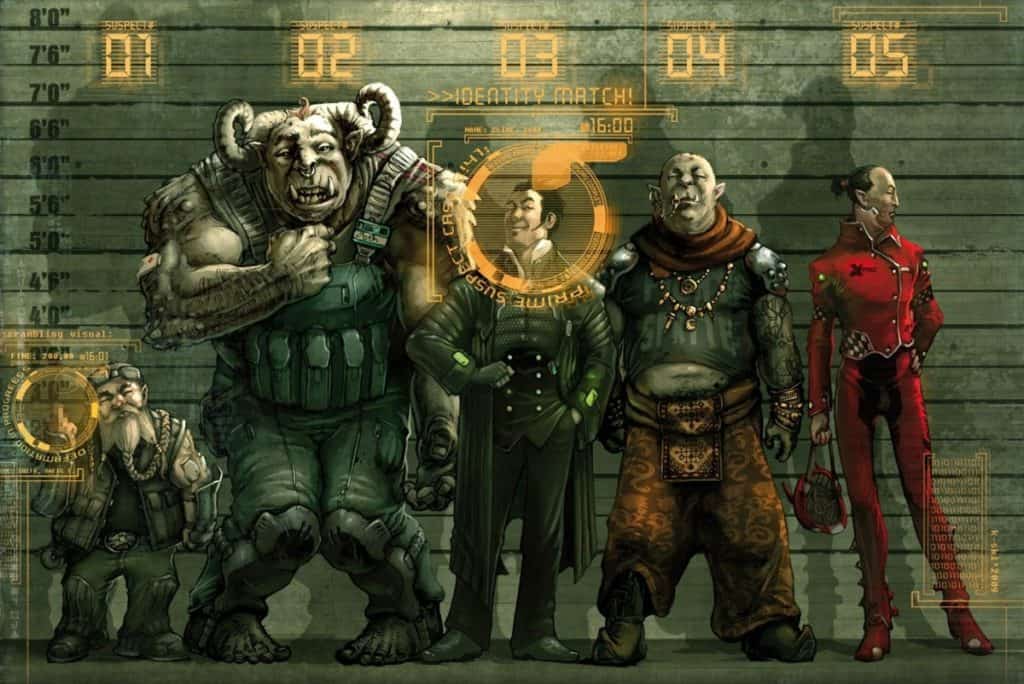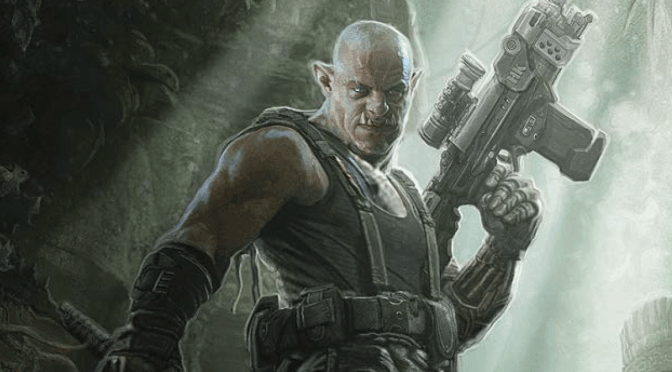Over the years, I have poked around and kept tabs on the Roleplaying Game Shadowrun. I even read some of the fiction books put out in the ’90s. But with the release of latest, Sixth, edition, I decided to do a deeper dive into this game.
Shadowrun combines fantasy tropes with a cyberpunk future. You play as Shadowrunners, mercenaries or idealists or simply desperate, living on the fringes of the Corporations. You get hired by these Corps as disposable or deniable assets to infiltrate, seize, or destroy people, technology, or data.
Shadowrun tells gritty and dark tales of people living on the edges of society. International Corporations were given near nation-state status. Their property and compounds act as embassies of sovereign nations. The only thing that matters to them is money and power.
As technology advanced, something strange happened in 2011: magic came into the world. This new era is called the Sixth World by magical historians. Along with the magic came dragons, long sleeping, and other fair and foul magical beasties.
But that’s not all, suddenly humans started mutating (usually right around or just after puberty). These new mutants, or meta-humans, evolved into several standard types: dwarves, elves, orcs, and trolls. As these meta-humans grew up and started families of their own, their new genetics bred true.
But as Mana flowed into the world, it altered the geography. Volcanoes, especially along the Pacific Rim, erupted. Magic and technology did not mix and nuclear reactors went haywire. Death and destruction sowed further distrust in the already impotent national governments. Across North America and Europe, countries fractured and new nations were born.
As I wrote in my explanation of Vampire the Masquerade, these two game systems compete with having the most thorough in-game canon. Where Vampire tells the story of a world hidden from mortals knowledge since before the Flood, Shadowrun tells of a future, a dystopia where Corporations are the apex predators. Shadowrun goes so far as to give players several pages of in-world jargon.
Also like Vampire, Shadowrun uses a dice pool mechanic. Instead of Vampire’s d10s, it uses d6s. This common design is not surprising as both systems originated in the late 1980s and early 1990s in response to the popularity of Dungeons and Dragons.
Tell me who you are Chummer?
Character creation starts with choosing a class. In Shadowrun, they call these Archetypes. These are the the classes or archetypes in Shadowrun 6th Edition:
- Arcane Specialist: the magic-wielders
- Face: the charming character, social butterfly, and smooth operator
- Street Samurai: The muscle, usually augmented by technology.
- Technology Specialist: A hacker on the Matrix or a rigger running vehicles remotely.

Within each of these archetypes, there are several ways you can go. Even with arcane specialist you can be a Dungeons & Dragons-style wizard, or a spirit summoning shaman, or a monkish adept who uses magic to fuel and perfect their own body. Mages are also the clerics, extending the D&D analogy with healing and enhancing magics.
The Archetypes for Shadowrun 6th Edition are:
- Adept: Magical Martial Artists
- Combat Mage: Blow them up and protect your allies
- Covert-Ops Specialist: Infiltrator, Cat Burglar, Fast Talker
- Decker: A Matrix Hacker, Computer Whiz (more on the Matrix below)
- Face: General, Negotiator, Diplomat
- Rigger: Melds their persona with vehicles of all types to transport Shadowrunners and give them remote fire support
- Street Samurai: Artificially enhanced muscle and walking weapons arsenal
- Street Shaman: Spirit Summoner, usually aligned with a Totem Animal.
- Technomancer: Matrix wizard, uses innate power (Resonance) to hack rather than technology.
The game also has you define your personality and willingness to confront the darker themes of the game: Wetwork, Racism, Addiction, and Human Trafficking. The game is about eking out a living on the fringes of society. If any of these themes are triggering for you, then talk with your Game Master about removing or minimizing them in-game.
Fiddly-Bits
Shadowrun has a long, notorious history of being a mechanically fiddly system. As a game, it tries really hard to be simulationist in its style and approach. This starts with character creation after figuring out who you are in the world.
Also like Vampire, Shadowrun uses a point-buy system for character creation. But the amount of points you have to spend is divided up into six pieces, called priorities A through F. Priority A has more points to spend than B, than C, etc. By the time you get to F, you get barely any bump.
You then assign your “priority” to each of the six different areas of creation:
- Metatype Bonus: how big of a bump you get for being the elfiest of elves.
- Attributes: Strength, Agility, Body, Willpower, Intelligence, and Charisma.
- Skills: something you know how to do, which is typically associated with a specific attribute.
- Magic or Resonance: Your innate magical ability.
- Resources: how much starting yet you have. The Nuyen or is the currency of the world.
Figuring out how many Attribute versus Skill versus the other Priorities you must pick can take a long time. Even with an online tool like Hero Lab, making a character takes a long time.
Also, there are trap choices for the different archetypes. If you’re a mage and you don’t have Magic as your A or B priority, you’re going to be underpowered as a character. Hackers need skills and resources as their equipment is expensive. Street Samurai need good attributes, skills, and resources (body modifications aren’t cheap).
Then on top of those choices, you then have to buy gear, spend bonus Karma (Karma is Shadowrun’s version of experience points), and determine the derived statistics (Attack Rating, Defense Rating, Initiative, etc.). This can get very complex for new players.
I want to blow something or someone up!
As mentioned above, Shadowrun uses a dicepool system. For each rank in an attribute or skill, that gives you a d6 for your dice pool. Each Attribute or Skill can have up to nine ranks. But the Karma costs grows rapidly as you gain ranks.

Tests can be two different Attributes (Composure is Willpower + Charisma) or an Attribute and a Skill. Shooting a shotgun is Firearms + Agility. If you have five ranks in each, then you are rolling ten d6s. The Game Master will tell you how many successes or hits it takes to succeed on the test.
A “Hit” is a 5 or 6 on the d6. But you also need to watch for 1’s. If more than half your dice rolled come up with a 1, then you have a critical glitch. This critical glitch happens regardless of whether or not you also got enough hits. For example of rolling ten d6s, if five or more of them are 1s, then it is a critical glitch.
Sometimes you are just trying to get above a threshold and the extra hits are meaningless. But in combat situation, the extra hits or net hits will increase the damage dealt or have some other “extra” effect.
The Matrix
Heavily influenced by the book, Neuromancer, by Gibson, the Matrix is a Virtual Reality that can be entered by anyone with the right gear. Those with commitment issues buy VR or AR googles. Artificial Reality simply imposes a heads-up display over what you are perceiving in “meat space.”
Going full VR means that you’re seeing and interacting with the Matrix. But when in full VR, your meat suit is at risk because you can’t perceive what is around you.
For those without commitment issues, they install a datajack straight into their brain. This allows them to directly access the Matrix with their brain. When that datajack is then connected to a Commlink or portable computer, the Decker can work their magic.
But there are dangers inside the Matrix. First you have to hack your way into the Corporations secure vaults if you want the good data, or access to their security cameras, or trying to lift some Nuyen. The Corps have their own global security ready to pounce on Deckers. The Grid Overwatch Division (G.O.D.) will call in SWAT teams if they discover an over-eager Decker spending too long in secure locations.
Besides G.O.D., corporations also have their own internal matrix security, called Spiders. These are real people trying to stop deckers. Finally, there is IC: Intrusion Countermeasures or simply ice. These are programs of various types, searching and destroying Deckers. Black Ice will reach through the Matrix and fry a Decker’s brain.
But being a Decker is more than just the Matrix. A Decker can also hack anything connected to a person’s commlink. This is called a PAN: Personal Area Network. Many weapons have a PAN connection to let the Street Samurai’s augmented eyes “see” what the gun sees and know exactly how many rounds are left. A good Decker can sever that connection or make the gun eject its clip.
Running the Shadows
At its most basic level of play, a Shadowrun is a three-act play. Act I is the setup. Act II is the legwork. Act III is the mission. A good example of this is the movie Oceans 11.

Act I: Setup
The first act usually starts with a job offer. A shadowrunning team usually has a fixer or two. The fixer is a person who matches shadowrunners to Mr. Johnsons.
In the Sixth World parlance, a Mr. Johnson is someone who, typically a corporate-type who has a job and is willing to pay good Nuyen for it. All such employers are called Mr. or Ms. Johnson or simply Johnson.
The Johnsons have preferred fixers, to whom they outline some of the basics of the job: a smash and grab, a distraction force, an extraction (a forcible human resources operation), or a quiet infiltration. The Fixer then reaches out to teams or individual Runners who are likely to excel at the mission. The Fixer earns a fee paid directly by the Johnson.
The team (all of them or a select few) will then have a meeting with the Johnson. The Johnson will explain the target, the preferred method of execution, other parameters (e.g. no killing of opposition forces), and the payment.
Of course, all Shadowrunners see that as a mere opening bid. The more dangerous the operation and the more limits on methods and techniques, the higher the payment should be. Of course, each group has a reputation to uphold.
This is where the Face character shines. Anyone can negotiate for more pay, after the fact. A good face gets money paid up front. A great face can get the Johnson to supply additional corporate resources: gear and equipment not available to those running the shadows.
Depending on whether or not the group is an established team, then there may be scenes where each Runner is recruited for the mission. This is more likely true for new campaigns, then after running a few times. Alternatively, each player could have two or three characters. This creates an ensemble, assembling the team feel to Act I.
Act II: Legwork
The Second Act is where the team then researches the target. If the team wants to maximize success, then they need to understand the tactical field of operation: entry points, exit points, security measures, etc.
A few words about Contacts. As part of character creation, the players should spend points on creating Contacts. These are non-player characters with whom they have a relationship of varying degrees. These contacts are information brokers, suppliers, fences, allies, and frenemies. During the Legwork stage, players will often utilize their contacts to gather mission intel.
But the Runners will also need to use their own skills and abilities. The Decker may need to obtain building blueprints. Not just the “official” ones field with the local government, but the “unofficial” sets that show the floorplan of the secret underground bunker.
The Face may try to befriend or blackmail a security guard or corporate decker. This will allow them to learn of routines, deliveries, holes in the security perimeter. Or it allows them to steal keycards, fingerprints, hair for forgery and duplication.
The Mages will need to do Astral surveillance. In the Sixth World spirits and magical effects exist in two worlds: the Physical and the Astral. Most mages can look into the Astral to see what permanent spells are guarding a security door. Some can even Astrally project themselves to scout the interior. The Corporate Security Mages may have an Air Spirit patrolling for Astral threats and snoops.
While the Decker, Mage, and Face are gathering intel, the Street Samurai is hitting up his weapon contacts for non-lethal rounds and sleep grenades. The Rigger is fixing up one of his bots for tunneling. Getting into the secret underground bunker silently is hard enough, getting back out the way you came is harder. Or maybe the Rigger is having to “borrow” a VTOL for a rooftop extraction.
Act III: The Mission
This is the action sequence of the movie. This is where the heist takes place. Either everything goes smoothly or the Decker rolls a critical glitch hacking the elevator that goes down into the Bunker. Now the security alarms are blaring: what do you do?
Assuming the mission is a success, then there is the little problem of getting paid. You must now get the stolen information, prototype, or scientist to your Ms. Johnson. Sometimes that goes without a hitch.
Other times, Ms. Johnson thinks the operation was so important that it best not to leave anyone alive who can tell the tale. By killing the Shadowrun team, she is probably also burning her Fixer contact. Or maybe the Fixer is already dead. That’s ok, she has access to an unlimited supply of corporate credsticks. There are a lot of hungry Fixers at the edges of the shadows.
Downtime
Another important aspect of play is downtime. The game builds in an assumption that there will be weeks or even months in-between missions. While levelling skills, attributes, and increasing your mana reserves requires the spending of Karma, it also requires the spending of in-game time.
Remember, Shadowrun tries very hard to be a simulationist, gritty experience. If you want to learn how to shoot guns better, you have to practice. That takes time and Nuyen. If you hire a teacher, it goes quicker but costs more Nuyen.
Or your Street Samurai needs the latest technology: Beta-Ware Wired Reflexes. The Street Doc needs to replace his entire peripheral nervous system so he can react faster to threats. That is going to take recovery time.
The Rigger had its drone fleet shot to hell on the last mission. Now she has to scrounge for parts and spend time fixing and repairing them. Yet more time. Or she needs to buy a bigger gun for her van. Her contacts have access to one, but it will take them three weeks to smuggle it into the City.
Meanwhile, your Runners can’t eat Nuyen and it doesn’t keep them warm at night. The game requires characters to spend their money every month for their food and shelter.
Finally, this is also where the game can get dark. As part of character creation, a character can get extra points to spend if they take a flaw, like Major Addiction. Or there are a number of pharmaceutical aids that can be used in combat, but only in emergencies. They work great, but coming down off of them is tough.
The game simulates addictions, withdrawal, and needing to buy greater amounts over time. This all plays out during downtime. If you’re playing with kids or younger teenagers, you may want to tread lightly here.
Actual Plays and Advice
With its long history, there are several Youtube and Podcast feeds I can suggest you explore. First there is Complex Action on Youtube that has great explainer videos. If you want a deep dive into the lore of the Sixth World, the Neo-Anarchist Podcast covers it, chronologically, in short 15-minute(ish) episodes.
The Arcology Podcast (giant corporate structures/buildings where its wage-slaves never have to leave are called arcologies). It is part of the Shadowcasters Network of Podcasts. They are all of good quality. Finally, I also like Geek the Mage Actual Play.
In summary, Shadowrun is a great system and even greater setting. But it is not for everyone. It does require a greater degree of system mastery because there are a ton of rules, systems, and sub-systems. It tries to simulate real-world physics in a game with magic and gets bogged down in the process. For players who want a rules-light version of Shadowrun, they should try Shadowrun Anarchy.
If you want to explore the wilder (and wider) world of tabletop roleplaying games go there! If you want to start to learn on how to paint miniatures, click already! Or maybe you want to read more of my posts about Dungeons and Dragons, then click away here!

